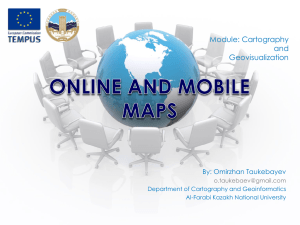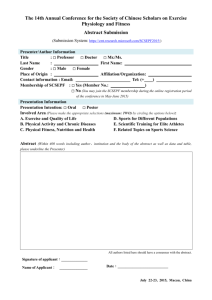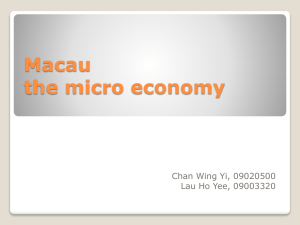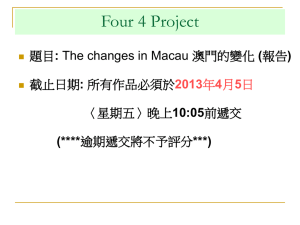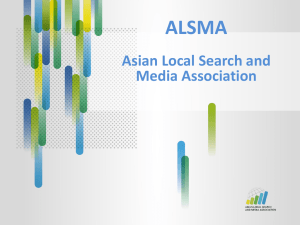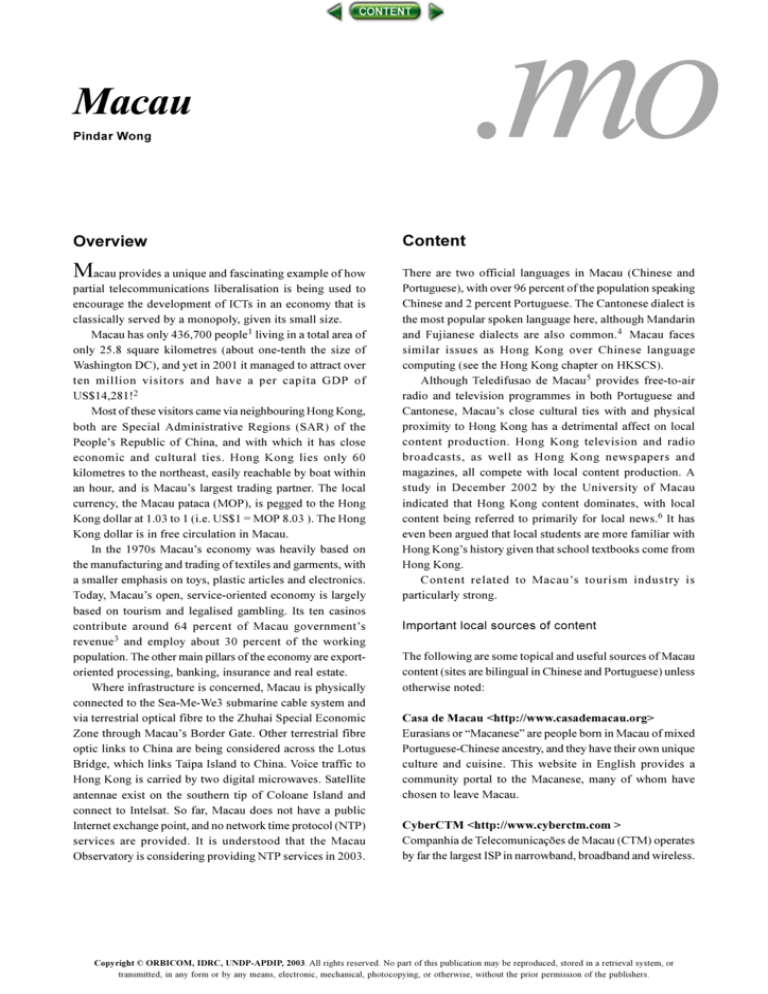
.mo
183
Digital Review of Asia Pacific 2003/2004 Macau
Macau
Pindar Wong
Overview
M
acau provides a unique and fascinating example of how
partial telecommunications liberalisation is being used to
encourage the development of ICTs in an economy that is
classically served by a monopoly, given its small size.
Macau has only 436,700 people1 living in a total area of
only 25.8 square kilometres (about one-tenth the size of
Washington DC), and yet in 2001 it managed to attract over
ten million visitors and have a per capita GDP of
US$14,281!2
Most of these visitors came via neighbouring Hong Kong,
both are Special Administrative Regions (SAR) of the
People’s Republic of China, and with which it has close
economic and cultural ties. Hong Kong lies only 60
kilometres to the northeast, easily reachable by boat within
an hour, and is Macau’s largest trading partner. The local
currency, the Macau pataca (MOP), is pegged to the Hong
Kong dollar at 1.03 to 1 (i.e. US$1 = MOP 8.03 ). The Hong
Kong dollar is in free circulation in Macau.
In the 1970s Macau’s economy was heavily based on
the manufacturing and trading of textiles and garments, with
a smaller emphasis on toys, plastic articles and electronics.
Today, Macau’s open, service-oriented economy is largely
based on tourism and legalised gambling. Its ten casinos
contribute around 64 percent of Macau government’s
revenue 3 and employ about 30 percent of the working
population. The other main pillars of the economy are exportoriented processing, banking, insurance and real estate.
Where infrastructure is concerned, Macau is physically
connected to the Sea-Me-We3 submarine cable system and
via terrestrial optical fibre to the Zhuhai Special Economic
Zone through Macau’s Border Gate. Other terrestrial fibre
optic links to China are being considered across the Lotus
Bridge, which links Taipa Island to China. Voice traffic to
Hong Kong is carried by two digital microwaves. Satellite
antennae exist on the southern tip of Coloane Island and
connect to Intelsat. So far, Macau does not have a public
Internet exchange point, and no network time protocol (NTP)
services are provided. It is understood that the Macau
Observatory is considering providing NTP services in 2003.
Content
There are two official languages in Macau (Chinese and
Portuguese), with over 96 percent of the population speaking
Chinese and 2 percent Portuguese. The Cantonese dialect is
the most popular spoken language here, although Mandarin
and Fujianese dialects are also common.4 Macau faces
similar issues as Hong Kong over Chinese language
computing (see the Hong Kong chapter on HKSCS).
Although Teledifusao de Macau5 provides free-to-air
radio and television programmes in both Portuguese and
Cantonese, Macau’s close cultural ties with and physical
proximity to Hong Kong has a detrimental affect on local
content production. Hong Kong television and radio
broadcasts, as well as Hong Kong newspapers and
magazines, all compete with local content production. A
study in December 2002 by the University of Macau
indicated that Hong Kong content dominates, with local
content being referred to primarily for local news.6 It has
even been argued that local students are more familiar with
Hong Kong’s history given that school textbooks come from
Hong Kong.
Content related to Macau’s tourism industry is
particularly strong.
Important local sources of content
The following are some topical and useful sources of Macau
content (sites are bilingual in Chinese and Portuguese) unless
otherwise noted:
Casa de Macau <http://www.casademacau.org>
Eurasians or “Macanese” are people born in Macau of mixed
Portuguese-Chinese ancestry, and they have their own unique
culture and cuisine. This website in English provides a
community portal to the Macanese, many of whom have
chosen to leave Macau.
CyberCTM <http://www.cyberctm.com >
Companhia de Telecomunicações de Macau (CTM) operates
by far the largest ISP in narrowband, broadband and wireless.
Copyright © ORBICOM, IDRC, UNDP-APDIP, 2003. All rights reserved. No part of this publication may be reproduced, stored in a retrieval system, or
transmitted, in any form or by any means, electronic, mechanical, photocopying, or otherwise, without the prior permission of the publishers.
184
Dr Ho 888 <http://www.drho888.com>
This is the online casino of Dr Stanley Ho, Macau’s casino
tycoon and father of the gambling industry, which was
previously monopolised by Sociedade de Tourismo e
Diversoes Macau.
International Library of the University of Macau
<http://www.umac.mo/lib/LIB.html>
Constructed in 1999, it is the largest library in Macau, with
state-of-the-art facilities and free public Internet access.
About 40 percent of its library material budget is allocated
to the acquisition and servicing of electronic resources
(commercial databases, e-books, e-journals, CD-ROM,
videos and Web-based material). It is also a depositary library
for more than ten international organisations (e.g. UN, EU,
WTO, APEC, NATO).
Macau Cable TV <http://www.macaucabletv.com>
In 1999, Macau Cable TV was awarded a 15-year franchise
to provide cable television services in Macau. In 2002, it
offered around 40 channels of content, most of it from
overseas.
Macao Daily News <http://www.macaodaily.com>
This is the largest-circulated daily newspaper in Macau (in
Chinese only).
Macau Productivity and Technology Transfer Centre
(CPTTM) <http://www.cpttm.org.mo>
Established as a non-profit organisation by the government and
the private sector, CPTTM promotes higher productivity and
stronger competitiveness of Macau firms by supporting their
use of new information resources and methodologies.
Macau government website <http://www.macau.gov.mo>
This is the official website of the Government of Macau
Special Administrative Region of the People’s Republic of
China.
Teledifusao de Macau <http://www.tdm.com.mo>
This is the only free-to-air television and radio broadcaster
in Macau, with programmes in Cantonese and Portuguese.
Their website provides streaming video capabilities.
Online services
Since 1995, commercial Internet services have been provided
by the CTM monopoly and a handful of pioneering
companies (Macau Internet Gateway Services, Macau Web Ltd,
MacauNet and Unitel). However, many of these companies
have since stopped trying to compete with CTM in the
provision of dial-up Internet access and have evolved into
content-hosting companies. In 2002, CTM was the only
provider of broadband services in Macau.
Digital Review of Asia Pacific 2003/2004 Macau
Macau facts
Total population: 436,700 (May 2002)30
Key economic sectors (with percentages
of GDP): Industry (15%), services (85%)31
GDP Per capita: US$14,281 (2001)32
Literacy in the national language(s): 90%
(male 93%, female 86%)33
Computer ownership per 100 inhabitants:
17.8634
Telephone lines per 100 inhabitants: 40.435
Telephones per 1,000 inhabitants: 84936
Internet hosts per 10,000 inhabitants: 4.2234
Internet users per 10,000 inhabitants:
2,254.46 34
Cell phone subscribers per 100 inhabitants:
44.537
Sources:
See notes.
As far as affordability and quality are concerned, Macau
has adopted an interesting public tariff structure where
service quality levels are inherent in the service licensing
criteria of both Internet and telecommunications services.
Regularly reviewed, Internet service tariffs are quoted on
the websites of the ISPs as well as on that of the new
regulator, the Office for the Development of
Telecommunications and Information Technology
(GDTTI).7
The tariffs and service quality requirements have led to
a very transparent market for Internet services, where basic
broadband services are available for MOP 160 (US$19.93)
per month with each hour costing MOP 2.8 (US$0.35).8
In 2000, the Internet services market was liberalised with
the government accepting applications for the provisional
licence of Internet service from 1 October. The regulation
on the provision of Internet services was finalised on 24
October. In October itself, 12 licences for Internet Services
were issued.9 Most of the licensees provide Web-application
or database-hosting services, with Companhia Chinesa 2000
Online (Macau) Limitada10 offering some competition to
CTM in dial-up Internet access. Unfortu-nately long-time
dial-up ISP MacauWeb stopped offering dial-up service from
12 September 2002. As of October 2002, there were 29,900
registered dial-up users who were online for a total of
1,046,016 hours. Since the introduction of ADSL broadband
Internet service by CTM in July 2000, Macau has seen a
steady increase in broadband usage. In July 2002, the total
number of hours spent online via dial-up and broadband was
about equal, at around 1,200,000 hours each. However, by
October 2002, 15,496 broadband subscribers used 450,000
more hours than dial-up users.
Copyright © ORBICOM, IDRC, UNDP-APDIP, 2003. All rights reserved. No part of this publication may be reproduced, stored in a retrieval system, or
transmitted, in any form or by any means, electronic, mechanical, photocopying, or otherwise, without the prior permission of the publishers.
185
Digital Review of Asia Pacific 2003/2004 Macau
There are only basic statistics on ICT usage in Macau
provided by the Statistics and Census Service.11 Angus
Cheong and his colleagues at the University of Macau have
conducted a number of interesting studies in 2001 and 2002
regarding how the Internet is being used in Macau. He found
that PC penetration in families was around 64 percent, with
71 percent of PC owners also having online access. On
average, the Internet was used for 9.5 hours per week with
6.1 hours from home, 2.3 hours from the workplace or school
and 1.1 hours from elsewhere. While online, 3.2 hours were
spent searching for information, 1.7 hours reading news, 1.5
hours on e-mail, 1.4 hours participating in chatrooms or
forums, and 1.3 hours playing games.12
Examples of innovative and
key initiatives
Macau has long fostered distance learning initiatives. In
March 1997, it began the Macau SchoolNet project with eight
schools and dial-up Internet access, and now almost all
educational institutions obtain subsidised Internet access via
CTM’s i.campus.13 CTM’s MacauELearning also offers the
possibility of online course authorship, enrolment, testing
and tracking.14
Enabling policies
The most significant enabling policy over the last two years
was the partial liberalisation of market monopolies in
gambling and telecommunications, thus allowing
competition. This is a fundamental shift in what was
previously a mutually beneficial relationship. Subsequently,
2 new mobile and 12 ISP licences have been issued by
GDTTI <http://www.gdtti.gov.mo>.
market and in June 2000 it split telecommunication
regulation from that of postal services with the formation of
GDTTI.15
The concession contract makes fascinating reading.16
Specifically, it agreed that CTM’s monopoly in fixed-line,
telegram and telex services, fixed service for data
transmission and rental circuit services was to be renewed
for another 12 years, until 31 December 2011. However,
Internet, mobile, long-distance voice telephony on mobile
and other value-added services were to liberalise in 2001.
Interestingly, CTM pays a 9 percent royalty of its total
operating revenue17 to the government, which reserves the
right to redeem the CTM concession in 2006 after a review
and by giving one year’s prior notice. The government also
reserves the right to terminate the concession in the “Public
Interest”.
After a selection from eight bids in October 2000, two
new entrants in the mobile market were issued mobile phone
licences on 1 March 2001: Hutchison Telephone (Macau)
Company Limited18 (a joint venture between Hong Kong’s
Hutchison Whampoa and Japan’s NTT DoCoMo) and
SmarTone Mobile Communications (Macau)19 (SmarTone
and Delta Asia Financial Group).20 These companies started
offering GSM 900/1800 mobile services in August 2001,
and as of October 2002 there were 173,085 subscribers of
mobile phone services (39.6 percent of total population) and
102,403 prepaid rechargeable SIM cards of public mobile
phone services. GPRS and WAP services are also offered.
One of the unsuccessful bidders teamed up with CTM to
offer its One2Free-branded mobile value-added services to
CTM customers.
In August 2002, Macau made an exciting move by
publishing regulations for the installation and operation of
external telecommunications infrastructures (e.g. submarine
cable).21
Regulatory environment
Certification authorities
Telecommunications services, prior to 1981, were provided
by the public sector in the form of Correios e
Telecomunicações de Macau. Since 1981, a private company
CTM enjoyed a monopoly under a concession contract from
the government.
CTM was formed in October 1981 with a registered
capital of MOP 70 million (US$8.7 million). It is a joint
venture between Cable and Wireless PLC (51 percent),
Portugal Telecom International (28 percent), CITIC Pacific
(20 percent) and the Macau SAR government (1 percent).
The 20-year exclusive licence, granted on 18 August 1981,
was revised by the Sino-Portuguese Liaison Group during
negotiations surrounding Macau’s return to Chinese
sovereignty, and an agreement on its renewal was reached
on 19 October 1999.
Under the terms of the renewal, Macau adopted a key
enabling policy by partially liberalising its telecommunications
In December 2002, there were no active certification
authorities (CA) in Macau. The Post Office (Correios de
Macau) is understood to be considering offering digital
certification services in 2003 and was running a logo design
competition for the proposed CA (eSignTrust) at the time of
writing.
Domain name registry
There are currently five second-level domains (“.com.mo”,
“.net.mo”, “.org.mo”, “.edu.mo” and “.gov.mo”) under the
“.mo” top-level domain, which is administered by the
University of Macau as MONIC.
Although “.mo” was registered by the university in 1992,
it was not until a leased line to the Internet was established
in 1994 that domain name services were offered to the public.
Copyright © ORBICOM, IDRC, UNDP-APDIP, 2003. All rights reserved. No part of this publication may be reproduced, stored in a retrieval system, or
transmitted, in any form or by any means, electronic, mechanical, photocopying, or otherwise, without the prior permission of the publishers.
186
Currently, there are no annual fees for third-level domain
names under “.mo” – only a single application fee of MOP
200 (US$25) per domain name is charged to cover
administration costs. Primary names servers for any thirdlevel domain name must be operated within Macau, and
individual domain names are not available under “.mo”.
Given the relatively stringent enforcement of registration
criteria, there are few domain name disputes. MONIC is a
founding member of the Chinese Domain Name
Consortium.22
According to the July 2002 Network Wizards’ Internet
Domain Survey, there are only 152 Internet hosts under the
“.mo” domain with 57 third-level domains registered.
To register under “.com.mo”, commercial entities need
to provide documentary evidence such as their Macau
business licence. See <http://www.umac.mo/sub-domain/subdomain.html> for more details.
Open source movement
Open source software is being actively promoted by local
ICT-related associations and educational bodies, with
CPTTM providing specific training in supporting Red Flag
Linux, a Chinese version of Linux developed by the Chinese
Academy of Sciences. This version of Linux has strong
support from the Chinese government. There is also a Tucows
mirror site hosted by CTM23 and a local Linux users group.24
Research into ICTs
Operating since July 1992, the United Nations University’s
International Institute for Software Technology (UNU/IIST)25
is a research and training centre specifically focused on the
software technology needs of developing countries. By
working with other universities in developing economies, it
helps to improve, develop and train their staff and students
in advanced software engineering techniques. By doing so,
it helps to strengthen their teaching and research curricula
in computer science and software engineering and their
ability to produce computer software.
In February 2001, Cisco Systems established its first
regional Networking Academy in Macau by partnering with
CPTTM. There is frequent collaboration on other research
and educational activities between the University of
Macau, 26 Macau Computer Association, 27 Macau
Information Technology Education Association 28 and
Macau Information Technology Association.29
Digital Review of Asia Pacific 2003/2004 Macau
Future trends
The next few years will be especially important for Macau
as the world watches if it successfully follows through with
its careful steps in liberalising the gambling and
telecommunications markets.
So far, there has been no serious competition to CTM in
the provision of Internet services in Macau and, with the
trend towards broadband services continuing, it would appear
that the only broadband provider, CTM, will only get
stronger at the expense of dial-up competitors. Already some
providers are withdrawing from the market (e.g. MacauWeb).
Given the existing tariff-based pricing, should service
costs become unaffordable or prohibitive, GDTTI would be
expected to respond accordingly. Perhaps the new regulations
on external facilities will attract competitive international
bandwidth to land in Macau (e.g. from Hong Kong) and
further drive prices lower, or market forces could replace
the existing tariff structure.
In any case, demand for international services are
expected to rise, especially after the new casino licensees
begin operations. Already the new mobile service providers
are leveraging their home networks in Hong Kong to help
service Macau tourists, the majority coming via Hong Kong.
With the development of remote monitoring services, it is
unclear whether the new casino operators will station their
monitoring staff in Macau or simply ship the video back to
Las Vegas where they already have the operating
infrastructure. International demand for data services will
also increase if Macau is successful in promoting itself as
an “offshore” financial and banking centre.
There will no doubt be further pressure on local content
development and the use of Portuguese as economic and
cultural ties between Macau, Hong Kong and China become
even closer (e.g. after construction of the Zhuhai-Hong Kong
bridge).
The risk of not fostering and maintaining Macau’s unique
Portuguese/Macanese cultural heritage is lost tourist and
trade opportunities with Portuguese-speaking economies
(e.g. Brazil, Mozambique, Portugal).
Finally, with the adoption of ICTs and the localisation
of the civil service, the development of e-government
initiatives will lead to increasing transparency and
responsiveness. Macau’s legal framework will need to be
upgraded to address the new opportunities created by
GDTTI.
Copyright © ORBICOM, IDRC, UNDP-APDIP, 2003. All rights reserved. No part of this publication may be reproduced, stored in a retrieval system, or
transmitted, in any form or by any means, electronic, mechanical, photocopying, or otherwise, without the prior permission of the publishers.
187
Digital Review of Asia Pacific 2003/2004 Macau
Select bibliography on Macau
8. CyberCTM tariffs <http://www.cyberctm.com/cs/tariff.en.
Chan, S.S, “The Liberalization of Macau’s
Telecommunications Market”. In Leading Issues of the
Macau Economy, Chapter 5, pp. 75–92. This provides
a short overview of how Macau’s telecommunications
sector has evolved over the last 20 years and touches
on issues surrounding its liberalisation.
Cheong, Weng Hin, (2000). “Internet Adoption in
Macau”. JCMC, 7(2) January. <http://www.ascusc.
org/jcmc/vol7/issue2/macao.html>. This and other
studies by Angus Cheong are probably the most
comprehensive studies on the impact of the Internet on
Macau to date.
Infocomm Development Authority of Singapore (2002).
Factbook on the Telecom and IT Industry in Asia. This
gives a useful executive overview of the
telecommunications market in the Asia-Pacific region,
with a brief section on Macau on page 65.
Lee Chi Ming Jimmy, (1996). “The Internet Market of
Macau: An Exploratory Study”, MBA thesis,
University of Macau. This provides a historical
snapshot of the Internet scene in Macau briefly after
commercial Internet services were introduced.
Leong Wan Chong. Macau 2020: The Long Term
Objectives and Development Strategies in 20 years,
pp. 55–115. Macau Development Strategy Research
Centre. This is an interesting study of how to position
Macau’s economy over the long term.
Telecom Daily, Issue 954, 23 October 2001. <http://
www.telecom-daily.com/asia/archive03/issue
%20954%20Macau.pdf> This contains a nice set of
tables summarising key telecommunications, Internet,
wireless and broadcasting statistics.
Yee, Herbert S. Macau in Transition: From Colony to
Autonomous Region. This fascinating book provides a
historical and political context of Macau’s return to
Chinese sovereignty. Chapter 7 on the Macanese is
illuminating.
9. GDTTI <http://www.gdtti.gov.mo/eng/Facts/ispliclist.html>.
phtml>.
10. Chinese 2000 Direct Network (Macau) Limited <http://
www.c2kol.net >.
11. Statistics and Census Service <http://www.dsec.gov.mo/html/
English/index.html>.
12. World Internet Project <http://www.cnnic.net.cn/news/91/
Social%20Impact%20of%20the%20Internet-CNNIC.ppt>.
13. CTM i.campus <http://www.i.campus.ctm.net>.
14. MacauELearning <http://www.macauelearning.com>.
15. Creation of the GDTTI <http://www.gdtti.gov.mo/por/laws/
67_2000.html>.
16. Concession Agreement <http://www.gdtti.gov.mo/eng/laws/
concession/ctm_chap1.htm>.
17. Concession Agreement, Chapter 8, <http://www.gdtti.
gov.mo/eng/laws/concession/ctm_chap8.htm>.
18. Hutchison Telecom – Macau <http://www.hutchison
macau.com/eng/index.jsp>.
19. SmarTone – Macau <http://www.smartone.com.mo>.
20. GDTTI <http://www.gdtti.gov.mo/eng/laws/index.html>.
21. GDTTI <http://www.gdtti.gov.mo/por/laws/16_2002.html>.
22. Chinese Domain Name Consortium <http://www.cdnc.org>.
23. Tucows Macau mirror site <http://tucows.macau.ctm.net>.
24. Macau Linux Community <http://www.macaulinux.org/
index.php>.
25. UNU/IIST <http://www.iist.unu.edu>.
26. University of Macau <http://www.umac.mo>.
27. Macau Computer Association <http://www.mca.org.mo>.
28. Macau Information Technology Education Association
<http://www.itea.org.mo>.
29. Macau Information Technology Association <http://www.
ita.org.mo>.
30. Statistics and Census Service, May 2002. Macau in Figures
<http://www.dsec.gov.mo/html/English/numeros/pdf/
2002.pdf>.
31. Statistics and Census Service, May 2002. Macau in Figures
<http://www.dsec.gov.mo/html/English/numeros/pdf/
2002.pdf >. Financial intermediation services were
indirectly measured, and an adjustment of –5.7 percent was
Notes
required to bring total GDP down to 100 percent.
32. Statistics and Census Service <http://www.dsec.gov.mo/
1. Statistics and Census Service, May 2002. Macau in Figures
<http://www.dsec.gov.mo/html/English/numeros/pdf
2002.pdf>.
2. Statistics and Census Service <http://www.dsec.gov.mo/
html/English/index.html>.
3. Macau Factsheet <http://www.macau.gov.mo/factsheet/
tourism_en.phtml>.
4. Macau Factsheet <http://www.macau.gov.mo/factsheet/
geography_en.phtml>.
5. TDM <http://www.tdm.com.mo>.
6. Interesting Study by Angus Cheong <http://www.himacau.
org.mo/survey>
7. GDTTI <http://www.gdtti.gov.mo>.
html/English/index.html>.
33. 1981 estimate, defined as age 15 years and above who can
read and write. <http://www.cia.gov/cia/publications/
factbook/geos/mc.html>.
34. ITU, (2002). Asia-Pacific Telecommunication Indicators
2002, p. A-20.
35. Statistics and Census Service, May 2002. Macau in Figures
<http://www.dsec.gov.mo/html/English/numeros/pdf/
2002.pdf>
36. Statistics and Census Service <http://www.dsec.gov.mo/html/
English/index.html>.
37. Statistics and Census Service, May 2002. Macau in Figures
<http://www.dsec.gov.mo/html/English/numeros/pdf/
2002.pdf>.
Copyright © ORBICOM, IDRC, UNDP-APDIP, 2003. All rights reserved. No part of this publication may be reproduced, stored in a retrieval system, or
transmitted, in any form or by any means, electronic, mechanical, photocopying, or otherwise, without the prior permission of the publishers.

